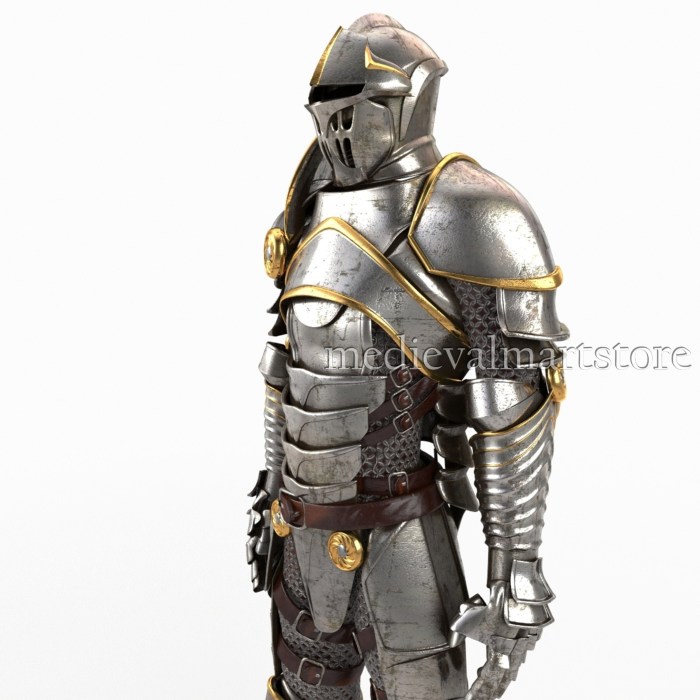Wearable suit of armour has captivated imaginations throughout history, from ancient battlefields to modern-day applications. This exploration delves into its origins, evolution, and enduring significance, unraveling the intricate tapestry of protection and artistry that defines this remarkable attire.
From the earliest known suits crafted from leather and bronze to the technologically advanced materials used today, armour has undergone a remarkable transformation, reflecting the ingenuity and adaptability of human civilization.
Wearable Suit of Armour: Historical Origins
The origins of wearable suits of armour can be traced back to ancient civilizations, where warriors sought protection from weapons and projectiles. The earliest known examples of armour date back to the Bronze Age, around 3000 BC, and consisted of simple bronze plates covering vital areas of the body.
Over time, armour design evolved as civilizations advanced and new materials became available. Iron and steel became the preferred materials for armour, offering greater strength and durability. Armourers developed intricate designs to distribute weight evenly and maximize protection while allowing for mobility.
Iconic examples of armour from different historical periods include the Greek hoplite armour, the Roman legionary armour, the medieval knight’s plate armour, and the samurai armour of feudal Japan.
Types and Styles of Wearable Armour

| Type | Key Features | Purpose |
|---|---|---|
| Plate Armour | Solid metal plates covering the body | Maximum protection in melee combat |
| Mail Armour | Interlocking metal rings forming a flexible mesh | Balance of protection and mobility |
| Scale Armour | Overlapping metal scales attached to a backing | Lightweight and flexible, suitable for archers and cavalry |
| Laminated Armour | Layers of leather, wood, or metal plates | Lightweight and affordable, used by infantry and skirmishers |
Armour construction varied depending on the materials and techniques available. Plate armour was made by hammering metal sheets into shape and assembling them with rivets or buckles. Mail armour was crafted by linking together thousands of metal rings. Scale armour was created by attaching individual scales to a leather or cloth backing.
Each type of armour had its advantages and disadvantages. Plate armour offered the best protection but was heavy and expensive. Mail armour was more flexible and lighter but less protective against piercing weapons. Scale armour provided a compromise between protection and mobility.
Armour Customization and Adornment

Armour often reflected the cultural and personal identity of the wearer. Knights and samurai decorated their armour with engravings, paintings, and other embellishments to display their lineage, achievements, and beliefs.
Heraldic symbols and crests were commonly used on armour to identify the wearer’s family or clan. These symbols were often emblazoned on shields, banners, and other military equipment.
Armour in Warfare and Combat
Armour played a crucial role in warfare, providing protection from enemy weapons and enabling soldiers to engage in close combat. Heavily armoured knights on horseback formed the backbone of medieval armies, while infantrymen relied on lighter armour for mobility.
Armour influenced combat strategies and weapon development. The advent of plate armour led to the development of specialized weapons like the war hammer and the poleaxe, designed to penetrate or crush armour.
Historical accounts are filled with examples of battles where armour played a decisive role. The Battle of Agincourt in 1415 saw heavily armoured English knights defeat a larger French army, thanks to their superior protection.
Armour in Art and Literature, Wearable suit of armour

Armour has been a source of inspiration for artists and writers throughout history. Paintings, sculptures, and other works of art depict warriors in armour, capturing their strength, courage, and heroism.
In literature, armour often symbolizes protection, power, and authority. Characters clad in armour represent the ideals of chivalry, honour, and duty.
Modern Applications of Wearable Armour
Modern materials and technologies have led to the development of new types of wearable armour for military and law enforcement purposes. Advanced materials like ceramic and composite fibres provide lightweight and durable protection.
Wearable armour is also finding applications in extreme sports, disaster response, and other fields. Protective suits are used by firefighters, bomb disposal experts, and riot control officers.
However, the use of wearable armour in modern society raises ethical considerations. Concerns have been raised about the potential for armour to escalate violence and the possibility of it being used for oppressive purposes.
FAQ Explained: Wearable Suit Of Armour
What are the earliest known origins of wearable armour?
The earliest known origins of wearable armour can be traced back to ancient Egypt and Mesopotamia, where leather and bronze were used to create rudimentary forms of protection.
How did armour evolve over time?
Armour evolved over time as new materials and technologies became available. From the use of iron and steel in ancient Greece and Rome to the development of plate armour in medieval Europe, armour became increasingly sophisticated and effective.
What are some examples of iconic armour from different historical periods?
Iconic armour from different historical periods includes the Greek hoplite armour, the Roman legionary armour, the medieval knight’s plate armour, and the samurai armour of feudal Japan.
What are the different types and styles of wearable armour?
There are various types and styles of wearable armour, each with its own unique features and purposes. These include chainmail, plate armour, brigandine, and lamellar armour.
How was armour customized and adorned?
Armour was often customized and adorned to reflect cultural and personal identity. This could include engravings, paintings, and other embellishments, as well as the use of heraldic symbols and crests.
